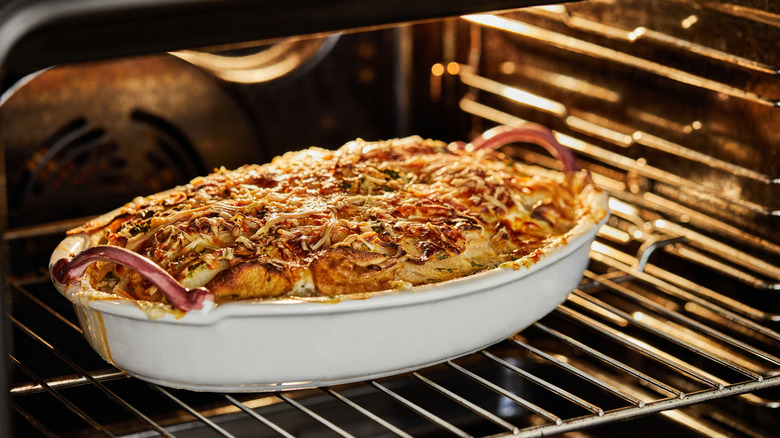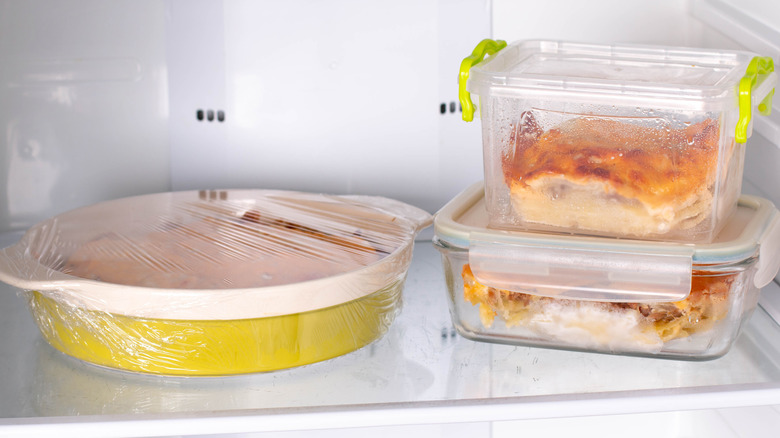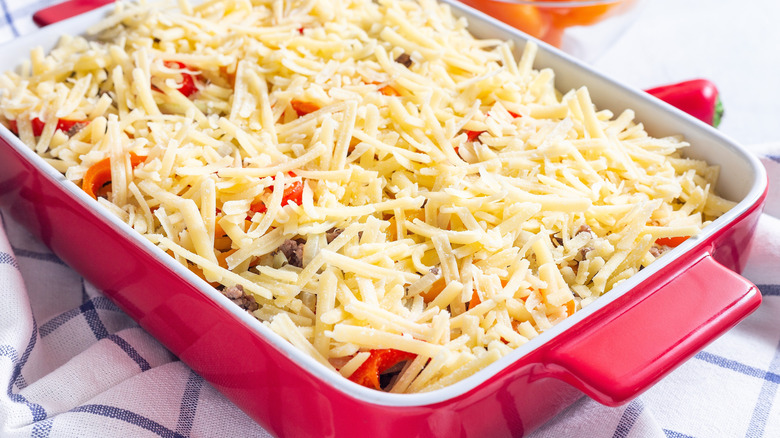The Absolute Best Way To Heat Up A Casserole In The Oven
Rose Sioson's experiences as a busy working mum inspired her to create Deliciously Rushed, where she publishes quick and delicious recipes. Many of these recipes can be refrigerated or frozen before being subsequently reheated and served. Because of this, Sioson was the person we turned to when wondering what the best way of heating up casseroles is.
Sioson reheats her casseroles in the oven. Using this approach has its benefits, but there are also several mistakes you'll want to avoid. Sioson told The Takeout, "Biggest one: cranking the heat too high. You'll end up with a scorched top and a cold center." She went on to say that most casseroles (assuming you've taken the time to defrost them) should go into an oven that's heated to 350 degrees Fahrenheit. Another big mistake? Forgetting to cover the casserole. "Always cover with foil, especially for cheese-topped or creamy casseroles," Sioson said. "If it looks a little dry, a splash of broth or milk can work wonders."
You must remember to check the casserole's internal temperature before serving it. According to the United States Department of Agriculture, leftovers should be heated to 165 degrees Fahrenheit, but Sioson likes to go higher. "I aim for at least 200 degrees Fahrenheit," she said. "Eyeballing it doesn't always cut it." (If you don't have a kitchen thermometer it is time to get one — it's one of several essential kitchen gadgets.)
Defrost frozen casserole in the fridge
When it comes to frozen casseroles, Rose Sioson said you should take time to save time. Ideally, you should put your casserole in the fridge to defrost the day before you plan to serve it. That time spent in the fridge will translate to time saved in the oven, and it'll improve the dish's taste and texture. "The fridge is your best friend," Sioson said. "Letting the casserole thaw slowly overnight helps everything warm evenly and prevents those sad frozen-in-the-middle moments." If you have the time, let your casserole rest on the counter for a few minutes after you've defrosted it. "I give it about 20 – 30 minutes on the counter before it hits the oven," Sioson said, before adding, "taking the chill off helps it reheat more evenly."
We've all forgotten to take food out to defrost, though, and Sioson gets it. "Can you go straight from freezer to oven? Technically yes," she said. "But you'll need to add extra time, cover it tightly with foil, and start with a lower oven temp to avoid burning the top before the inside is hot." While a freshly defrosted casserole typically takes just 20 to 30 minutes to sufficiently heat up in an oven heated to 350 degrees Fahrenheit, she explained that frozen casseroles should be cooked at lower temperatures for longer periods of time.
Plan ahead when making casseroles
Rose Sioson switches up her techniques depending on the kind of casserole she's making. Baking a casserole (which is different to hotdish) before freezing it, for example, can help prevent dairy from developing that dreaded grainy texture. She recommended freezing cooked pasta dishes too, saying, "If it's pasta-based or contains dairy (like béchamel or cheese sauce), I usually bake it first, cool it completely, then freeze. That helps maintain texture. For veggie or meat-heavy casseroles, I'll often freeze them unbaked and cook fresh."
Sometimes, you might want to partially make your casseroles before freezing them. For example, shepherd's pie has a filling that responds well to freezing, but the mashed potato topping won't freeze very well. In this scenario, you should freeze the filling and only make the mashed potatoes on the day you serve the dish.
Sioson also said that it's important to wrap your casserole before sticking it in the freezer. The closer it is to being airtight the better as cold, dry air causes freezer burn. "Wrap it really well—foil, plastic wrap, and a labeled freezer bag if you're being extra," Sioson said. Even better? Get a vacuum sealer. "My vacuum sealer has been a total game-changer," she noted, adding that the vacuum sealer clears up space in the freezer. "If you freeze casseroles often, it's one of those gadgets that pays for itself."


